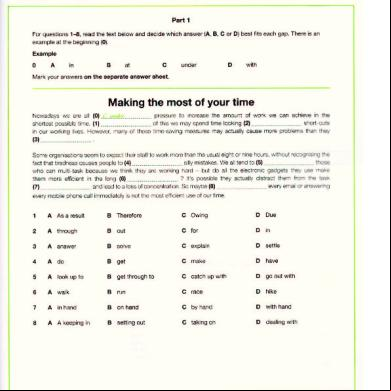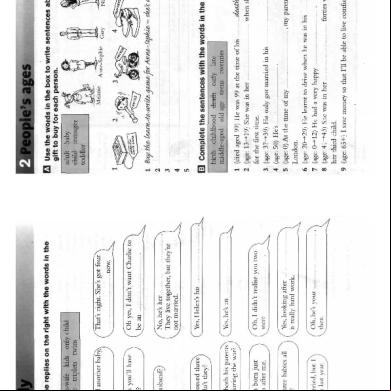1. The Benefits Of Bibliotherapy x3n1k
This document was ed by and they confirmed that they have the permission to share it. If you are author or own the copyright of this book, please report to us by using this report form. Report 3b7i
Overview 3e4r5l
& View 1. The Benefits Of Bibliotherapy as PDF for free.
More details w3441
- Words: 620
- Pages: 16
The Benefits of Bibliotherapy
Elfera, Hamzah, Nurafiqah, Ravi, Shanu
OIntroduction to Bibliotherapy OBenefits of Bibliotherapy to
Individuals OBenefits of Bibliotherapy to
Groups OUsefulness of Bibliotherapy in
Problem Solving OPositive Behavioral Outcomes
Definition
“The use of books to help people solve problems” (Aiex, 1993). It is the sharing of literature to facilitate structured interaction between the facilitator and the participant.
Benefits of Bibliotheraphy for Individuals • Helps people to cope with their emotional pressures • Helps to boost up self awareness • Changes people’s thought • Moral values are instilled in them
Benefits to Group
Increases sense of belonging and reduces anxiety.
Provides Extends an outlet Increases awareness for Leads to empathy beyond students better and the one's own who are family, ability to understanding reluctant of group community take the to seek norms and , and perspectives expectations help backgroun of others individuall d y
Bibliotheraphy : usefulness in problem solving/ conflict/ resolution
HOW? Do you have a favourite author or book that you read repeatedly because the message in the author’s books or the favourite book seems to speak to you and your life? Have you read a book to change your behaviour, such as a diet, self-help, or inspirational book? Then you have used bibliotheraphy to guide your life, solve a problem, or make a change in your personal behaviour. That is what bibliotheraphy means: using books to solve problems (Forgan, 2002).
• Teacher discuss with the pupils on how to solve the character’s conflict in the story.
I Identify the problem. S Solutions to the Problem? O Obstacles to the Solutions? L Look at the Solutions Again— C Choose One. V Very Good; Try it! E Evaluate the Outcome. From Teaching Problem Solving Through Children’s Literature by James Forgan. ©2002 Libraries Unlimited (800) 225-5800 or www.lu.com
Steps in Using Bibliotheraphy As a Problem Solving Method Element #1: Pre-reading Step 1: • Selecting books to read must be done carefully to insure that books are age and topic appropriate so that children will relate to the characters. Step 2: • Once the book is selected, teachers should help students activate prior knowledge and background experiences that will link them to the book’s content. Using the book cover to peak interest, a toy, picture of the character, or asking a linking question that suggests the topic are methods used by some teachers. Teachers may offer a Venn diagram, KWL, or a graphic organizer to predict about the topic.
Element #2: Guided Reading • Reading and reflection are used in guided reading. Read the entire story uninterrupted before discussion or questions begin. After reading, allow a few moments for individual reflection by asking students write in journals, discuss with Peer Partners, or simply sit quietly to think about the story. Element #3: Post-reading discussion Step 1: • To ensure that everyone comprehends the story, teachers should call on students to retell the plot and evaluate character’s feeling and situations. Step 2: • Now the class is ready to discuss the story in depth by responding to questions about their feelings and how they might relate to the characters.
Positive Behaviora l Outcomes
• Improved ability to understand and cope with problems and issues • Increased social sensitivity, empathy, and respect for others • Improved personal and social judgment • Increased understanding of human behavior and motivations • Increased ability to transcend or seek help for personal challenges and problems
The Goals of Bibliotherapy in Helping Children
• Identify and validate their feelings • Realize that other children have problems similar to their own • Stimulate discussion • Foster thought and self-awareness • Discover possible coping skills and solutions • Decide on a constructive course of action
THANK YOU
Elfera, Hamzah, Nurafiqah, Ravi, Shanu
OIntroduction to Bibliotherapy OBenefits of Bibliotherapy to
Individuals OBenefits of Bibliotherapy to
Groups OUsefulness of Bibliotherapy in
Problem Solving OPositive Behavioral Outcomes
Definition
“The use of books to help people solve problems” (Aiex, 1993). It is the sharing of literature to facilitate structured interaction between the facilitator and the participant.
Benefits of Bibliotheraphy for Individuals • Helps people to cope with their emotional pressures • Helps to boost up self awareness • Changes people’s thought • Moral values are instilled in them
Benefits to Group
Increases sense of belonging and reduces anxiety.
Provides Extends an outlet Increases awareness for Leads to empathy beyond students better and the one's own who are family, ability to understanding reluctant of group community take the to seek norms and , and perspectives expectations help backgroun of others individuall d y
Bibliotheraphy : usefulness in problem solving/ conflict/ resolution
HOW? Do you have a favourite author or book that you read repeatedly because the message in the author’s books or the favourite book seems to speak to you and your life? Have you read a book to change your behaviour, such as a diet, self-help, or inspirational book? Then you have used bibliotheraphy to guide your life, solve a problem, or make a change in your personal behaviour. That is what bibliotheraphy means: using books to solve problems (Forgan, 2002).
• Teacher discuss with the pupils on how to solve the character’s conflict in the story.
I Identify the problem. S Solutions to the Problem? O Obstacles to the Solutions? L Look at the Solutions Again— C Choose One. V Very Good; Try it! E Evaluate the Outcome. From Teaching Problem Solving Through Children’s Literature by James Forgan. ©2002 Libraries Unlimited (800) 225-5800 or www.lu.com
Steps in Using Bibliotheraphy As a Problem Solving Method Element #1: Pre-reading Step 1: • Selecting books to read must be done carefully to insure that books are age and topic appropriate so that children will relate to the characters. Step 2: • Once the book is selected, teachers should help students activate prior knowledge and background experiences that will link them to the book’s content. Using the book cover to peak interest, a toy, picture of the character, or asking a linking question that suggests the topic are methods used by some teachers. Teachers may offer a Venn diagram, KWL, or a graphic organizer to predict about the topic.
Element #2: Guided Reading • Reading and reflection are used in guided reading. Read the entire story uninterrupted before discussion or questions begin. After reading, allow a few moments for individual reflection by asking students write in journals, discuss with Peer Partners, or simply sit quietly to think about the story. Element #3: Post-reading discussion Step 1: • To ensure that everyone comprehends the story, teachers should call on students to retell the plot and evaluate character’s feeling and situations. Step 2: • Now the class is ready to discuss the story in depth by responding to questions about their feelings and how they might relate to the characters.
Positive Behaviora l Outcomes
• Improved ability to understand and cope with problems and issues • Increased social sensitivity, empathy, and respect for others • Improved personal and social judgment • Increased understanding of human behavior and motivations • Increased ability to transcend or seek help for personal challenges and problems
The Goals of Bibliotherapy in Helping Children
• Identify and validate their feelings • Realize that other children have problems similar to their own • Stimulate discussion • Foster thought and self-awareness • Discover possible coping skills and solutions • Decide on a constructive course of action
THANK YOU










